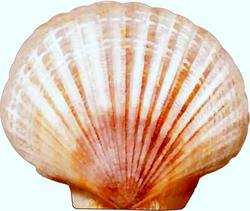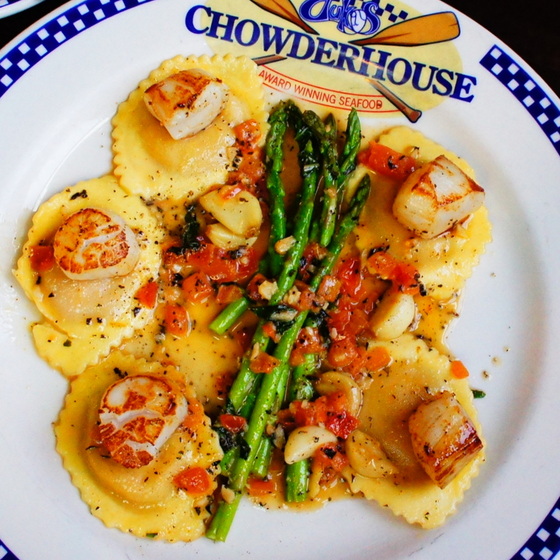The scallop is a hermaphrodite marine mollusc with primitive eyes that discern light and dark, and a strong, meaty (and succulent) adductor muscle. Like its cousins the oyster, the clam and the mussel, the scallop filter-feeds on plankton. Unlike most bivalves in the wild, it can propel itself through the water to avoid predators like crabs and starfish.
Commercial scallop fishing on the west coast of North America didn't start until the 1950s, when boatmen from the over-fished east coast moved across the continent. The American industry has grown quickly. Today, some 90 percent of the world's scallops are commercially farmed, mostly in China and Japan, over a million metric tons a year. But the best, by all accounts, are the wild Alaska Weathervane Scallops from a small fishery in the vast waters between Yakutat and the Aleutians. They even have their own Facebook page.
 "Nobody goes to Alaska," says Duke Moscrip, owner of the six restaurants that bear his name. "The fishermen never see any of their buyers."
"Nobody goes to Alaska," says Duke Moscrip, owner of the six restaurants that bear his name. "The fishermen never see any of their buyers."
But Duke goes. He goes to Westport on the Washington coast to check on the shrimp and crab operations on the Washington coast (which we wrote about for Cornichon backin August; he goes to Alaska for the salmon, the halibut, and the scallops, and he's found three scallop boats (with their own website, even) that will handle the catch his way. the Ocean Hunter, the Arctic Hunter, and the Provider: small lots, hand-shucked and frozen on board immediately after they are pulled from the icy Gulf, packed in five-pound boxes clearly marked with name and date to ensure traceability. Each boat has an independent, at-sea observer on board to ensure that Alaska's rigorous practices of sustainability are followed. Unlike other scallops on the market, the weathervanes are free of phosphates, preservatives, and unwanted chemicals.
The scallops served at Duke's weigh in at just under an ounce apiece. Over lunch at the Lake Union store, Duke calls them his "Oh My God" scallops. "The product is incredible. There's nothing like them. We sear them to a caramelized golden brown, and then we stop. They don't need a tricky sauce, and they certainly don't need overcooking." The menu currently features scallop sliders, scallops and prawns in a chop chop salad, scallops atop pumpkin ravioli, bacon-scallop tacos, scallops with melon, a scallops and prawns mixed grill, a scallops and baby back ribs combo. All for the next two months.
A former Bothell High basketball star, a former stock broker, one of the original owners of Ray's Boathouse, at the helm of Duke's Chowderhouse for 35 years, Duke Moscrip has become an evangelist for sustainable seafood. "Nobody else drills down like this," Duke admits. It's almost an indulgence, this intense level of personal, on-site research.
 He certainly wouldn't have time to do it if he didn't have his son John, now 36, running the company's day-to-day operations as well as a fanatically loyal corporate chef, Bill Ranniger. They've had a lock on the chowder market for several decades (using IQF clams from Chesapeake Bay, another in-person inspection) in a recipe executed at the Duke's commissary in Woodinville.
He certainly wouldn't have time to do it if he didn't have his son John, now 36, running the company's day-to-day operations as well as a fanatically loyal corporate chef, Bill Ranniger. They've had a lock on the chowder market for several decades (using IQF clams from Chesapeake Bay, another in-person inspection) in a recipe executed at the Duke's commissary in Woodinville.
What's remarkable is that Duke's Chowderhouse isn't some fancy-pants dinner house but solidly mid-market and unpretentious. A three-course dinner special goes for $21.30.
Food writers sometimes forget that Seattle might have a couple of thousand serious, self-described "foodies" who buzz around a handful of trendy bistros, it has an industry of well over 4,000 restaurants to feed a populace of over half a million. Duke's six restaurants seat over 900 indoors, with fair-weather outdoor seating for another 500, and employ a peak staff of 300. The company grosses $15 million a year, roughly the same dollar volume as the Space Needle, roughly the same as Salty's, but harder to do when the average check is $25 rather than $50 (Salty's), $60 (Needle) let alone $100+ (Canlis).
Duke's maintains a strong mailing list (40,000 names) to get the word out to his regulars about specials like the weathervane scallops, a three-month fishery. He and chef Ranniger are also regular bloggers on topics that range from environmental sustainability to culinary (chowder recipes) to political (minimum wage versus tip credit).
What else is on Duke's corporate horizon? A revolutionary way to treat halibut, bringing in frozen-at-sea filets to Seattle. Line-caught rock fish. Something with razor clams. Mexican white shrimp, wild-caught in the Sea of Cortez because the Gulf of Mexico is too polluted with iodine-laden runoff from the Mississippi.
There's a famous spot in New York, P.J. Clarke's, that serves upscale pub food on red checkered tablecloths, a decor that inspired Duke's. But on a recent trip to the Big Apple it was Soho's yacht-themed Lure Fishbar that reeled in the Moscrips, father and son. "Mutiny by a bounty of relishes," complained Frank Bruni's snarky review in the NYTimes. Duke asked about the "Roasted Atlantic Salmon" ($28) and was appalled that the server didn't know the fish was farmed. Worst of all, the chefs he talked to didn't realize there was an alternative, the environmentally sustainable wild salmon runs of Alaska. (His own menu reads "Duke personally supervised the catch of salmon in Alaska. No farmed salmon ever!")
"Nobody in New York has our level of sourcing, of environmental awareness," Duke contends. For that matter, it would be hard to find folks in Seattle with that sense of commitment. The 22-unit Anthony's chain was forced to launch its own seafood company 30 years ago to ensure a steady supply of decent fish. McCormick & Schmick has just been sold to a Texas chain not known for its commitment to seafood. Ivar's has expanded to 25 quick-serve units and sells its chowder in supermarkets. Duke is convinced he's got an edge on his competitors because he doesn't treat his seafood like a commodity.
"Our story is so compelling," he says. Then he takes off his glasses and looks out the window at the sailboats in the marina. Dreaming a bit, perhaps, he wonders, "Can you imagine what would happen if we brought our products to New York?"
Duke's Chowderhouse, multiple locations, www.dukeschowderhouse.com
Note: this post also appeared this morning, in slightly different form, on Crosscut.com.


Leave a comment